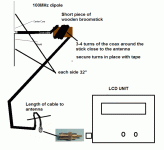Since this hobby is *technically* my sons (9yo) - it's his responsibility to push, build, modify everything within reason. He wants to upgrade the antenna and sound from last year - and I think I've got it all figured out. This way I can have all the BOM on hand and steps laid out for him to succeed.
Last year we used a Whole House Transmitter 3.0 (sitting on a light fixture outside the garage ~45' from street) off a Pi4 audio jack. It was sufficient. You'd get sound a few houses down the street and it was strong enough in front.
This year the Pi4 and WH FM3.0 are moving out into the yard in a CG1500 mounted on the megatree pole and also adding a Soundblaster Play3. Looking to go to a dipole antenna attached to a literal tree about 10' away from the megatree pole. This will get the antenna 10' from the street. Following along here HOW TO MAKE A DIPOLE FM TRANSMITTER ANTENNA looks to be where we will go, but that leaves a few clarifications and questions.
We'd need to get:
1. STA to coax adapter for the connection at the WH FM 3.0
2. 1:1 balun? THIS GUY MAYBE? to connect the coax and then use the outputs in the T for the antenna. Is there a reason to go 4:1?
I'm envisioning running the coax from the FM3.0 out the CG1500, down the pole, across some grass, then up into the PVC T, connecting at the balun. Reading the instructions for the antenna build, we could alter steps 8-12 to rather than clipping off the excess steel cable (would still solder to keep in place/maintain tension) - take the excess directly into the top connections for the linked balun.
Does this make sense with a good chance of being a successful project? I like to have stuff like this for him over the summer in the garage (rainy days in FL) to do on his own and keep him working on problems. Lots of short steps that can be start/stop and picked up later so it looks like a great one for him.
Thanks in advance for any ideas or suggestions.
Last year we used a Whole House Transmitter 3.0 (sitting on a light fixture outside the garage ~45' from street) off a Pi4 audio jack. It was sufficient. You'd get sound a few houses down the street and it was strong enough in front.
This year the Pi4 and WH FM3.0 are moving out into the yard in a CG1500 mounted on the megatree pole and also adding a Soundblaster Play3. Looking to go to a dipole antenna attached to a literal tree about 10' away from the megatree pole. This will get the antenna 10' from the street. Following along here HOW TO MAKE A DIPOLE FM TRANSMITTER ANTENNA looks to be where we will go, but that leaves a few clarifications and questions.
We'd need to get:
1. STA to coax adapter for the connection at the WH FM 3.0
2. 1:1 balun? THIS GUY MAYBE? to connect the coax and then use the outputs in the T for the antenna. Is there a reason to go 4:1?
I'm envisioning running the coax from the FM3.0 out the CG1500, down the pole, across some grass, then up into the PVC T, connecting at the balun. Reading the instructions for the antenna build, we could alter steps 8-12 to rather than clipping off the excess steel cable (would still solder to keep in place/maintain tension) - take the excess directly into the top connections for the linked balun.
Does this make sense with a good chance of being a successful project? I like to have stuff like this for him over the summer in the garage (rainy days in FL) to do on his own and keep him working on problems. Lots of short steps that can be start/stop and picked up later so it looks like a great one for him.
Thanks in advance for any ideas or suggestions.

